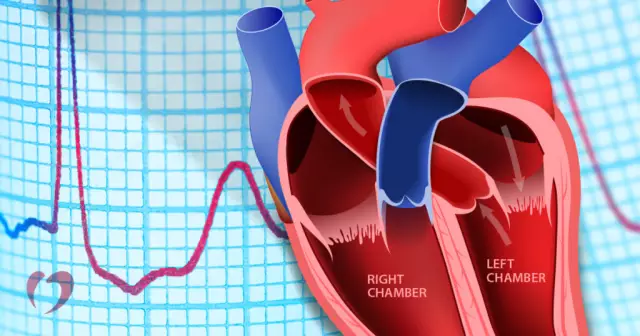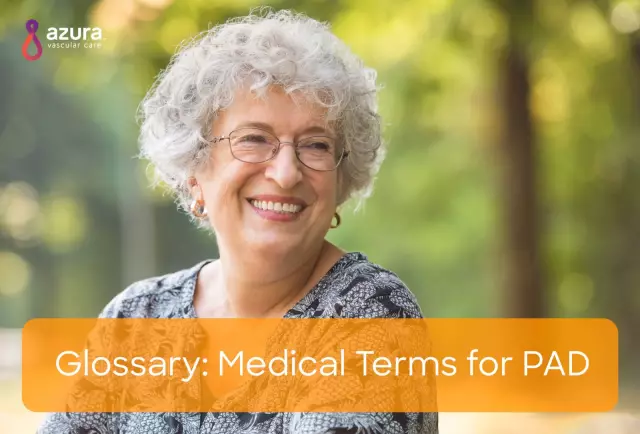- Author Rachel Wainwright [email protected].
- Public 2023-12-15 07:39.
- Last modified 2025-11-02 20:14.
His bundle branch block
The content of the article:
- Causes and risk factors
- Forms of the disease
- Symptoms
- Diagnostics
- Treatment
- Possible complications and consequences
- Forecast
A blockade of the bundle of His is a disease that manifests itself in a violation of the conduction of excitation (nerve impulse) through the tissues of the heart. It occurs in more than 0.5% of the population, the frequency increases with age: in persons over 60 years of age it is 1-2%.
Every fifth patient diagnosed with myocardial infarction already has conduction defects or is developing against the background of an acute condition.
The bundle of His (atrioventricular, or atrioventricular bundle) is represented by atypical muscle fibers; it conducts nerve impulses arising in the tissues of the right atrium from the pacemaker along the atria to the ventricles, determining the strength and frequency of heart contractions. In the interatrial septum, the bundle of His is divided into right and left legs (the left one has anterior and posterior branches), which propagate in the myocardium of the corresponding ventricles by the smallest structural elements - Purkinje fibers.

A blockade of the bundle of His is manifested by a violation of the conduction of a nerve impulse through the tissues of the heart
In case of violation of the conduction of excitation along the fibers of the His bundle (slowing down or blockade, partial or complete), there is a change in the sequence, speed and strength of excitation and contraction of the heart tissues, or myocardial contractility in a limited area suffers.
Causes and risk factors
The reasons that can cause a violation of the conduction of excitation along the structures of the His bundle are divided into cardiac and extracardiac.
Cardiac causes of blockades:
- congenital and acquired heart defects (stenosis of the orifices of the aorta, pulmonary artery, left atrioventricular opening, coarctation, or segmental narrowing, orifice of the aorta, insufficiency of the aortic, mitral valves, pulmonary valve, atrial septal defects);
- cardiomyopathy (including hypertrophic obstructive cardiomyopathy);
- coronary artery disease;
- dystrophic changes in the myocardium;
- idiopathic calcification of the cardiac conduction system;
- Brugada syndrome;
- fibrotic changes in the legs of the bundle of His;
- ischemic heart disease (including myocardial infarction);
- cardiosclerosis (including postinfarction);
- Levy's disease;
- heart failure;
- myocarditis;
- endocarditis;
- hypertrophy of the left ventricular myocardium.
Extracardiac Causes:
- intoxication with drugs of the cardiac glycoside group, quinidine, beta-blockers;
- thyrotoxicosis;
- electrolyte imbalance;
- severe or long-term diabetes mellitus;
- Iron-deficiency anemia;
- metabolic syndrome;
- alimentary obesity;
- chronic alcoholic illness;
- autoimmune diseases (rheumatoid arthritis, systemic lupus erythematosus, autoimmune thyroiditis);
- pulmonary embolism;
- chronic obstructive pulmonary diseases (obstructive bronchitis, bronchial asthma);
- long experience of smoking.
Forms of the disease
In accordance with the anatomical structure of the atrioventricular bundle, the following types of blockages are distinguished:
- single-bundle - one of the structures suffers (right leg of the bundle of His, anterior or posterior branch of the left leg);
- two-beam - a combined lesion of the right leg and one of the branches of the left, or a violation of the conduction of nerve impulses along both branches of the left leg;
- three-beam - simultaneous defeat of the right and left legs of the bundle of His.
Symptoms
The blockade of the right bundle branch of His is asymptomatic and is an accidental finding, revealed by the results of an ECG study during a planned medical examination, medical examination or treatment for other diseases.
Single-beam (anterior or posterior) left blockades also do not have clinically significant manifestations.
The left bundle branch block has symptoms of the disease that caused it, more often it is:
- decreased exercise tolerance;
- shortness of breath with slight physical exertion;
- interruptions in the work of the heart;
- palpitations;
- pain in the region of the heart;
- change in heart sounds during auscultation [weakened or lengthened I tone (in 70% of cases), less often (16% of cases) - its splitting, splitting of II tone (80%)].

Blockade of the left bundle branch branch causes shortness of breath even with minor physical exertion
Three-beam blockade has the most severe clinical manifestations:
- extremely low heart rate - 20-40 beats / min;
- severe shortness of breath at rest;
- interruptions in the work of the heart;
- heart rhythm disturbances;
- dizziness;
- short-term episodes of loss of consciousness;
- cyanosis of the skin.
Diagnostics
The main diagnostic measures:
- electrocardiography;
- daily ECG monitoring;
- transesophageal electrophysiological examination of the heart.
Laboratory research methods do not allow diagnosing a bundle branch block and can be used to identify the underlying disease that led to conduction disturbance.

ECG monitoring and electrocardiography are the main methods for diagnosing a bundle branch block
Treatment
There is no specific treatment for this pathology; first of all, the correction of the underlying disease is carried out with nitrates, cardiac glycosides, antihypertensive drugs.
With blockade of the right bundle of His bundle in the absence of the underlying disease, pharmacotherapy is not indicated.
For left leg block or three-beam blockade, the following therapy is prescribed:
- group B vitamins;
- antioxidants and antihypoxants;
- antiplatelet agents;
- hypolipidemic agents.

Drug therapy is indicated for left bundle branch block or three-beam block
If pharmacotherapy is ineffective, surgical treatment is indicated.
Possible complications and consequences
Complications of a bundle branch block can be:
- heart rhythm disturbances;
- heart failure;
- thromboembolism;
- acute heart failure.
Forecast
The prognosis depends on the severity of the underlying disease. With a single-beam block or right leg block, the prognosis is favorable.
Left bundle branch block and complete three-bundle block are prognostically less favorable. Mortality in this case increases 5 times, the average survival rate is 3.3 years; with a normal size of the heart, it lengthens to 4.3 years, with an increase in the size of the heart, the average survival rate is shortened to 2.5 years.
The prognosis is worsened by heart failure, cardiomegaly, angina pectoris, a history of myocardial infarction, atrial fibrillation, deviation of the electrical axis to the left.
Registered in acute myocardial infarction, regardless of whether it was before the infarction or developed in connection with it, the blockade of the left bundle branch of His increases the mortality rate of patients up to 60%.

Olesya Smolnyakova Therapy, clinical pharmacology and pharmacotherapy About the author
Education: higher, 2004 (GOU VPO "Kursk State Medical University"), specialty "General Medicine", qualification "Doctor". 2008-2012 - Postgraduate student of the Department of Clinical Pharmacology, KSMU, Candidate of Medical Sciences (2013, specialty "Pharmacology, Clinical Pharmacology"). 2014-2015 - professional retraining, specialty "Management in education", FSBEI HPE "KSU".
The information is generalized and provided for informational purposes only. At the first sign of illness, see your doctor. Self-medication is hazardous to health!






